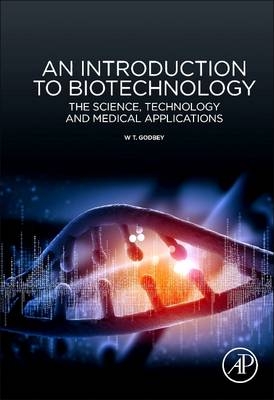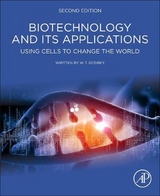
An Introduction to Biotechnology
Academic Press Inc.(London) Ltd (Verlag)
978-0-08-101506-3 (ISBN)
- Titel erscheint in neuer Auflage
- Artikel merken
Biotechnology is a field that encompasses both basic science and engineering. There are currently few, if any, biotechnology textbooks that adequately address both areas. Engineering books are equation-heavy and are written in a manner that is very difficult for the non-engineer to understand. Numerous other attempts to present biotechnology are written in a flowery manner with little substance. The author holds one of the first PhDs granted in both biosciences and bioengineering. He is more than an author enamoured with the wow-factor associated with biotechnology; he is a practicing researcher in gene therapy, cell/tissue engineering, and other areas and has been involved with emerging technologies for over a decade. Having made the assertion that there is no acceptable text for teaching a course to introduce biotechnology to both scientists and engineers, the author committed himself to resolving the issue by writing his own.
W. T. Godbey is the Paul H. and Donna D. Assistant Professor in the Department of Chemical and Bimolecular Engineering at Tulane University. He received his B.S. in Mathematics from Southern Methodist University in 1988. After a successful period that involved starting his own software design and development company in Dallas, Texas, he joined the fields of science and engineering and earned his PhD as a National Science Foundation Graduate Fellow from the Institute for Biosciences and Bioengineering at Rice University in 2000. From 2000-2003 he was a postdoctoral fellow at Childrens Hospital, Boston and Harvard Medical School. He joined the Tulane University faculty in 2003.
List of Figures
List of Tables
Preface
About the Author
Chapter 1: Membranes
Abstract
1.1 Membrane Lipids
1.2 Cholesterol
1.3 Membrane Proteins
Questions
Chapter 2: Proteins
Abstract
2.1 Amino Acids
2.2 Protein Structure
2.3 The Hydrophobic Effect
2.4 A Return to Membranes
Questions
Chapter 3: Cellular Transport
Abstract
3.1 Membrane Transporters
3.2 Vesicular Transporters: Endocytosis
3.3 Receptor Fates
3.4 Lysosomes Are for Degradation, But Are They Safe?
Questions
Chapter 4: Genes: The Blueprints for Proteins
Abstract
4.1 Nucleotides and Nucleic Acids
4.2 From Genes to Proteins
Questions
Chapter 5: Cell Growth
Abstract
5.1 The Eukaryotic Cell Cycle
5.2 Growth Curves and Their Phases
5.3 Mathematics of the Growth Curve
5.4 Counting Cell Numbers
5.5 Counting Cell Mass
5.6 Scale-Up
Questions
Chapter 6: Microbial Killing
Abstract
6.1 The Gram Stain
6.2 Microbial Resistance to Killing
6.3 Sterilization, Disinfection, and Sanitization
6.4 Microbial Cell Death
Questions
Chapter 7: Cell Culture and the Eukaryotic Cells Used in Biotechnology
Abstract
7.1 Adherent Cells Versus Nonadherent Cells
7.2 Primary Cells, Cancer Cells, and Cell Lines
Questions
Chapter 8: Fluorescence
Abstract
8.1 Stokes' Experiments
8.2 Fluorophore Properties
8.3 Fluorescence Detection
8.4 FRET
Questions
Chapter 9: Locating Transcriptional Control Regions: Deletion Analysis
Abstract
9.1 An Example of Deletion Analysis
Questions
Chapter 10: Agarose Gels
Abstract
10.1 Application of Agarose Gels: Gel Shift
10.2 Application of Agarose Gels: DNA Footprinting
10.3 Application of Agarose Gels: Restriction Analysis
Questions
Chapter 11: The Polymerase Chain Reaction
Abstract
11.1 Melt
11.2 Anneal
11.3 Extend
11.4 PCR Loops
11.5 An Application of Traditional PCR
11.6 Traditional Versus Real-Time PCR
11.7 Real-Time PCR
Questions
Chapter 12: Genetic Engineering
Abstract
12.1 Plasmid Architecture
12.2 Molecular Cloning
12.3 A Single Plasmid Is Not Enough
12.4 Spectrophotometry
12.5 What We Have Learned so Far
Questions
Chapter 13: Gene Delivery
Abstract
13.1 Gene Delivery Vehicles: An Overview
13.2 Gene Methods in Greater Detail
13.3 Preparation of Nonviral Gene Delivery Complexes
Questions
Chapter 14: RNAi
Abstract
14.1 Cosuppression
14.2 RNA Interference
14.3 miRNA
Questions
Chapter 15: DNA Fingerprinting
Abstract
15.1 Older DNA Fingerprinting Uses RFLPs
15.2 Newer DNA Fingerprinting Uses STRs
Questions
Chapter 16: Fermentation, Beer, and Biofuels
Abstract
16.1 Glycolysis
16.2 Fermentation
16.3 The Production of Beer
16.4 Fermentation to Produce Biofuels
Questions
Chapter 17: Stem Cells and Tissue Engineering
Abstract
17.1 Potential
17.2 An Alternate View of Stem Cells
17.3 Using Stem Cells
17.4 Tissue Engineering and Regenerative Medicine
17.5 Bioreactors
17.6 Polymeric Scaffolds
17.7 Bringing it all Together: A Tissue Engineering Application
Questions
Chapter 18: Transgenics
Abstract
18.1 Ice-Minus Bacteria
18.2 Bt Plants
18.3 Herbicide Resistance
18.4 Tomatoes
18.5 Rice
18.6 Terminators and Traitors
Questions
Chapter 19: Patents and Licenses
Abstract
19.1 Types of Patents
19.2 Licenses
19.3 After a License Is Granted
Questions
Index
| Erscheinungsdatum | 05.11.2017 |
|---|---|
| Verlagsort | London |
| Sprache | englisch |
| Maße | 152 x 229 mm |
| Themenwelt | Naturwissenschaften ► Biologie ► Genetik / Molekularbiologie |
| Naturwissenschaften ► Biologie ► Zellbiologie | |
| Technik ► Umwelttechnik / Biotechnologie | |
| ISBN-10 | 0-08-101506-2 / 0081015062 |
| ISBN-13 | 978-0-08-101506-3 / 9780081015063 |
| Zustand | Neuware |
| Haben Sie eine Frage zum Produkt? |
aus dem Bereich



